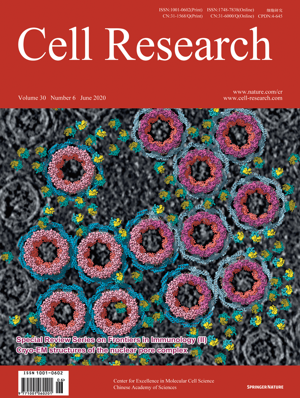
Advanced Search
Submit Manuscript
Advanced Search
Submit Manuscript
Volume 30, No 6, Jun 2020
ISSN: 1001-0602
EISSN: 1748-7838 2018
impact factor 17.848*
(Clarivate Analytics, 2019)
Volume 30 Issue 6, June 2020: 532-540 |
Molecular architecture of the luminal ring of the Xenopus laevis nuclear pore complex
Yanqing Zhang1,2,† , Sai Li3,4,† , Chao Zeng4,† , Gaoxingyu Huang3,† , Xuechen Zhu1,2,† , Qifan Wang1,2 , Kunpeng Wang5 , Qiang Zhou1,2 , Chuangye Yan3 , Wusheng Zhang5 , Guangwen Yang5 , Minhao Liu3 , Qinghua Tao3 , Jianlin Lei3 , Yigong Shi1,2,3,4,*
1Key Laboratory of Structural Biology of Zhejiang Province, School of Life Sciences, Westlake University, 18 Shilongshan Road, Hangzhou, Zhejiang 310024, China;The nuclear pore complex (NPC) mediates the flow of substances between the nucleus and cytoplasm in eukaryotic cells. Here we report the cryo-electron tomography (cryo-ET) structure of the luminal ring (LR) of the NPC from Xenopus laevis oocyte. The observed key structural features of the LR are independently confirmed by single-particle cryo-electron microscopy (cryo-EM) analysis. The LR comprises eight butterfly-shaped subunits, each containing two symmetric wings. Each wing consists of four elongated, tubular protomers. Within the LR subunit, the eight protomers form a Finger domain, which directly contacts the fusion between the inner and outer nuclear membranes and a Grid domain, which serves as a rigid base for the Finger domain. Two neighboring LR subunits interact with each other through the lateral edges of their wings to constitute a Bumper domain, which displays two major conformations and appears to cushion neighboring NPCs. Our study reveals previously unknown features of the LR and potentially explains the elastic property of the NPC.
https://doi.org/10.1038/s41422-020-0320-y